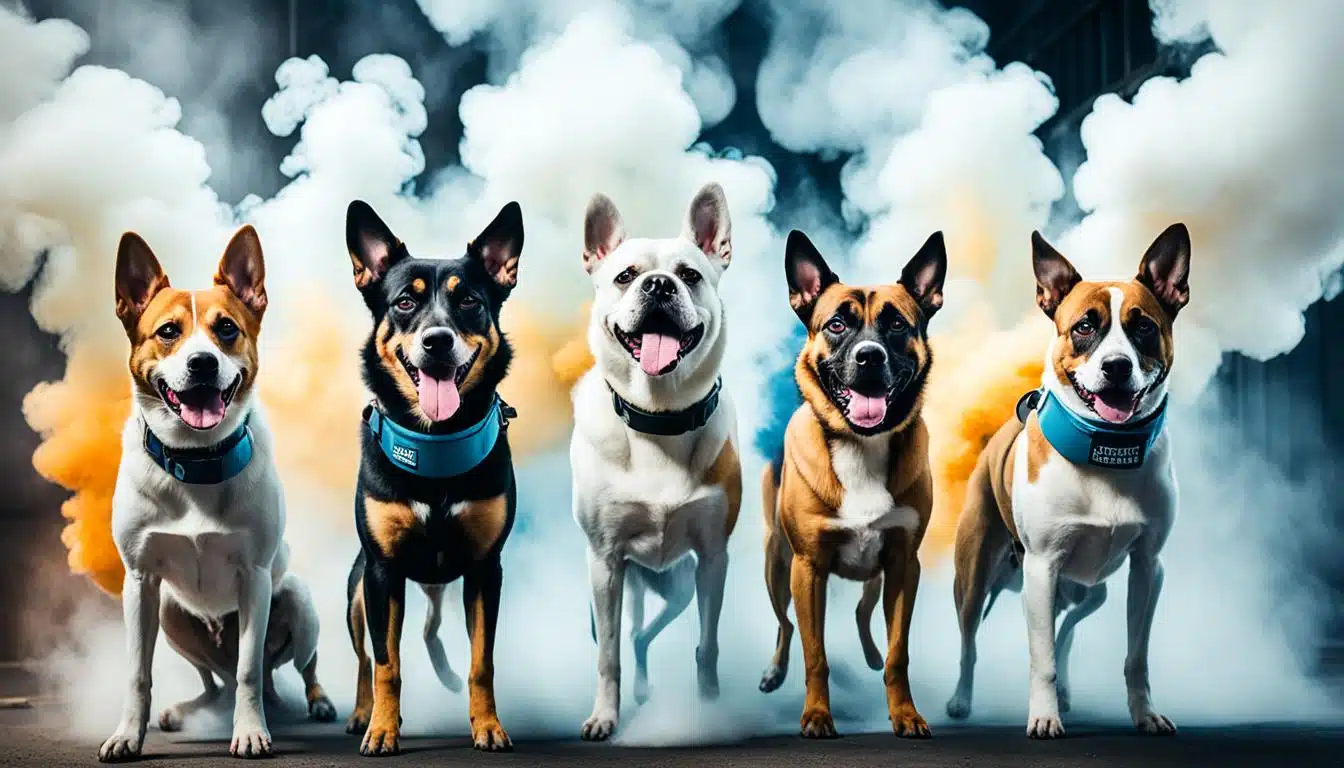When chaos erupts, and the air fills with the pungent scent of tear gas, we often worry about our fellow humans, but what about our four-legged companions? Have you ever wondered about dogs’ tear gas immunity when protests turn tumultuous? It’s time to address the burning question that concerns pet owners and law enforcement alike: Can man’s best friend withstand the eye-watering effects of this chemical agent?
My attention to dog tear gas tolerance springs from the collective anxiety of those responsible for canines in potentially volatile environments. This article seeks to explore the dynamic between tear gas and dogs’ health, delving into the truth behind the notion of their supposed resilience. Join me as we embark on a comprehensive journey to unravel the myths and realities surrounding our canine companions and their interaction with tear gas.
Key Takeaways
- Exploring the common belief about dogs’ immunity to tear gas.
- Understanding the relationship between a dog’s health and its exposure to tear gas.
- Examining the science behind dog tear gas tolerance versus human susceptibility.
- Looking at the immediate need for accurate information on the topic.
- Setting the stage for in-depth investigation into canine physiology and tear gas.
- Seeking practical measures for canine protection in riot scenarios.
What is Tear Gas and How Does It Affect Organisms?

When exploring whether dogs are immune to tear gas or not, it’s pivotal to understand what tear gas is and the way it influences living organisms. This section peels back the layers of tear gas, scrutinizes its chemical composition, and evaluates its impact on mammals—from the biological response to the repercussions seen in crowd control situations, weaving a narrative on the tear gas impact on dogs and their overall dogs tear gas effects.
Components of Tear Gas: The Chemical Breakdown
Tear gas, often used for its powerful irritant properties in crowd control, is a term for a concoction of chemicals. These substances are not gases but rather fine powders that are aerosolized to produce an immediate inflammatory effect on mucous membranes. The common compounds in tear gas include 2-chlorobenzalmalononitrile (CS gas), chloroacetophenone (CN gas), and oleoresin capsicum (OC). Each of these chemicals can provoke severe discomfort, disorientation, and temporary blindness, serving the intended purpose of crowd dispersal.
The Biological Response to Tear Gas in Mammals
The way mammals react to tear gas is a testament to its potency. Upon exposure, the chemicals trigger a burning sensation in the eyes, mouth, throat, lungs, and skin. The body’s immediate response includes excessive tear production, salivation, coughing, and difficulty breathing. These physiological processes are defense mechanisms that aim to expel the foreign agent, though they can also leave an individual incapacitated, which often raises the question—are dogs immune to tear gas, or do they suffer the same effects?
Tear Gas Use in Crowd Control: Human vs. Animal Impact
The deployment of tear gas in crowd control presents different challenges for humans and animals. While humans can understand the situation and seek to move away from the source, animals, particularly dogs, may become disoriented and frightened, which complicates their response to the irritant. Assessing dogs tear gas effects is crucial in this context as their heightened senses might make them more vulnerable to the chemical agents used.
Understanding Dogs’ Sensory System: How It Differs from Humans
As a journalist passionate about canine welfare, I’ve delved into the intricacies of a dog’s sensory experience and discovered fascinating differences from our own human senses. This understanding is pivotal when considering the impact of irritants like tear gas on our four-legged friends. Let’s uncover the nuances of canine perception that influence their experience, particularly when exposed to tear gas. It’s essential for us, as caring pet owners and dog enthusiasts, to recognize these aspects to ensure their safety and well-being.
Canine Olfactory Capabilities: More Than Just Sense of Smell
The olfactory prowess of dogs is legendary—their sense of smell is estimably more acute than that of humans. This heightened sensitivity means that dogs tear gas exposure can have an intensified effect, overloading their delicate sense receptors. It’s not just about the intensity of the odor but also about the complex detection of chemical components that could lead to more pronounced dog tear gas symptoms.
The Anatomy of a Dog’s Eyes and Its Susceptibility
Focusing on ocular anatomy, a dog’s eyes might not rival their noses in sensitivity, but they possess a unique structure that could influence their canine tear gas resistance. With a larger surface area exposed to the environment, irritants such as tear gas can cause significant discomfort and potential damage. Understanding this vulnerability is crucial in protecting them during potential exposure scenarios.
Dogs’ Physical Response Mechanisms to Irritants
The natural defense mechanisms dogs employ in response to irritants are both remarkable and essential for their protection. From rapid blinking to increased tear production, these reflexive actions help mitigate the adverse effects of tear gas. However, the robustness of these physical responses may not always be enough to combat the strong chemicals present in tear gas, underscoring the need for proactive protective measures for our canine counterparts.
| Dog Sensory System | Human Sensory System | Impact of Tear Gas |
|---|---|---|
| Highly developed sense of smell | Less-developed sense of smell | More intense and possibly overwhelming for dogs |
| Larger ocular surface area | Smaller ocular surface area | Greater potential for irritation and discomfort in dogs |
| Natural defense mechanisms (blinking, tearing) | Similar defense mechanisms | May not offer sufficient protection for dogs against chemicals |
Historical and Documented Cases of Dogs and Tear Gas Exposure

When I began investigating how tear gas affects our canine friends, it was crucial for me to look beyond theoretical possibilities and examine real-world encounters. Unveiling the documented cases of dogs that have experienced tear gas exposure provides us with concrete instances to assess both short and long-term effects. These historical examples serve as a significant gauge to evaluate dog tear gas symptoms and the level of dogs tear gas immunity.
Among several cases, one that stands out is the usage of tear gas during protests where police dogs were employed. Reports from these events detailed tear gas impact on dogs, noting symptoms such as excessive tearing, blinking, and mild respiratory distress. However, these were typically transient symptoms, as the dogs recovered shortly after being removed from the contaminated area and receiving fresh air.
- Cases of police dogs exposed during crowd control
- Observations of dogs affected in public incidents involving tear gas
- Reports from pet owners whose dogs were inadvertently exposed to tear gas
Through these records, it’s clear that while dogs may exhibit an acute response to tear gas, there is no evidence to suggest they possess an inherent immunity. On the contrary, the presence of dog tear gas symptoms indicates that these animals are indeed affected by such irritants. Thankfully, the resilience of their sensory system seems to allow for a relatively swift recovery, though this does not negate the potential danger of exposure, especially in uncontrolled situations.
As a responsible pet owner or canine handler, acknowledging these risks is paramount. By learning from past incidents, we can better prepare and protect our loyal companions from the possibility of tear gas exposure. It reassures us that with proper care and immediate attention, the risk to our dogs can be mitigated—highlighting the importance of awareness and preparedness in safeguarding our pets’ well-being.
Protective Measures for Canines During Protests and Riots
As we’ve explored the repercussions of tear gas on our canine companions, the significance of preventive strategies becomes evident. My intention is to equip dog owners and law enforcement handlers with knowledge that could shield their loyal friends in unpredictable scenarios. Protective measures for dogs against tear gas are not only about immediate responses but also involve a series of preparations that are essential in high-risk environments.
Proactive Strategies to Shield Dogs from Tear Gas
In the face of potential chaos, employing proactive strategies is fundamental to maintain canine tear gas resistance. Dogs tear gas exposure can be lessened through immediate evacuation from the scene whenever possible. Planning escape routes in advance, familiarization with signs of unrest, and the rapid identification of safe havens are crucial components of a comprehensive safety plan. It’s not about hoping for the best but preparing for the unforeseen.
Canine Protective Gear: From Masks to Bodysuits
When avoidance is not an option, protective gear rises to the forefront as an indispensable line of defense against tear gas. Specialized masks designed for canines can filter out harmful chemicals and safeguard their respiratory systems—consider them akin to K9 gas masks. Additionally, canine bodysuits can protect against skin irritants and debris that accompany such environments. Investing in these tools can be viewed as a necessary precaution to maximize protection.
Training Your Dog for High-Stress Environments
Finally, mental and emotional preparation should not be overlooked. Training your dog to navigate high-stress environments effectively can be just as vital as physical barriers. This involves exposure to varied stimuli, command reinforcement, and fostering a sense of security amid chaos. A dog well-acquainted with strain is a dog that’s better equipped to handle the rigors of tear gas exposure and the pandemonium that often comes with it.





